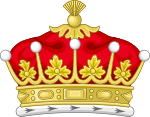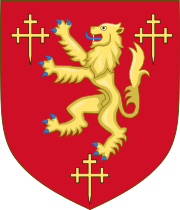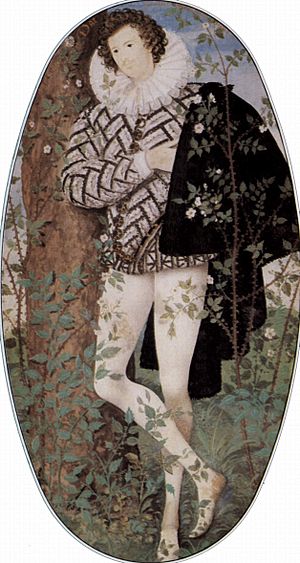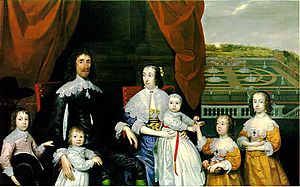Earl of Essex facts for kids
Quick facts for kids Earldom of Essex |
|
|---|---|
 
Arms of Capell, Earl of Essex: Gules, a lion rampant, between three cross crosslets fitcheeé or
|
|
| Creation date | 1139 (first creation) 1199 (second creation) 1239 (third creation) 1376 (fourth creation) 1461 (fifth creation) 1540 (sixth creation) 1543 (forfeit 1553–59) (seventh creation) 1572 (eighth creation) 1671 (ninth creation) |
| Monarch | Stephen (first creation) John (second creation) Henry III (third creation) Edward III (fourth creation) Edward IV (fifth creation) Henry VIII (sixth creation) Henry VIII (seventh creation) Elizabeth I (seventh creation, restoration) Elizabeth I (eighth creation) Charles II (ninth creation) |
| Peerage | Peerage of England |
| First holder | Geoffrey de Mandeville, 1st Earl of Essex |
| Present holder | Paul Capell, 11th Earl of Essex (ninth creation) |
| Heir presumptive | William Jennings Capell |
| Subsidiary titles | Viscount Malden Baron Capell of Hadham |
| Former seat(s) | Cassiobury House |
| Motto | Fide et fortitudine (By faith and fortitude) |
The Earl of Essex is a very old and important title in England. It was first created way back in the 12th century by King Stephen of England. This title has been given out nine different times to different families throughout history. Each time, it was like starting fresh with a new "first Earl."
Some of the most famous people to hold this title include Thomas Cromwell (who worked for King Henry VIII) and Robert Devereux, 2nd Earl of Essex (who was a favorite of Queen Elizabeth I). Robert Devereux even led a rebellion in 1601!
Today, the Earl of Essex is Paul Capell, 11th Earl of Essex, who was born in 1944. He used to be a school teacher. The main family home for the Capell Earls of Essex was once Cassiobury House in Watford, Hertfordshire.
Contents
- What is an Earl?
- History of the Essex Title
- The Capell Family Earls
- Homes of the Earls of Essex
- List of Earls of Essex
- Earls of Essex, first creation (around 1139)
- Earls of Essex, second creation (1199)
- Earls of Essex, third creation (1239)
- Earls of Essex, fourth creation (1376)
- Earls of Essex, fifth creation (1461)
- Earls of Essex, sixth creation (1540)
- Earls of Essex, seventh creation (1543)
- Earls of Essex, eighth creation (1572)
- Barons Capell of Hadham (1641)
- Earls of Essex, ninth creation (1661)
- Family Tree
- See also
What is an Earl?
An Earl is a high-ranking noble title in the Peerage of England. It's one of the oldest titles, ranking above a Viscount but below a Marquess. The title is usually passed down through the family, often from father to son. If there are no male heirs, the title can become "extinct" (meaning it ends) or "dormant" (meaning it's inactive until someone proves they are the rightful heir).
History of the Essex Title
The title of Earl of Essex has a long and interesting history, being created many times for different families.
First Earls: Mandeville Family
The very first Earl of Essex was Geoffrey de Mandeville, 1st Earl of Essex, in the 12th century. After his grandson, the third Earl, died in 1189, the title became inactive.
Second Creation: Fitz Peter Family
Later, in 1199, King John brought the title back for Geoffrey Fitz Peter, 1st Earl of Essex. His family was connected to the first Earls. This title also ended when the last son, William, died without heirs.
Bohun and Other Families
The title was created a third time in 1239 for Humphrey de Bohun, 2nd Earl of Hereford. This line of Earls also ended in 1373. Over the centuries, the title was created several more times for different important families, including a brief time for Thomas Cromwell, King Henry VIII's chief minister.
Devereux Family and Queen Elizabeth I
One of the most well-known creations was in 1572 for Walter Devereux, 1st Earl of Essex. His son, Robert Devereux, 2nd Earl of Essex, became very famous. He was a close friend and favorite of Queen Elizabeth I. However, he later led a rebellion against her in 1601. His son, Robert Devereux, 3rd Earl of Essex, was a general during the English Civil War. This line of Earls also ended.
The Capell Family Earls
The current line of Earls of Essex belongs to the Capell family.
Beginning of the Capell Title
The Capell family comes from Sir Arthur Capell. His grandson, Arthur Capell, 1st Baron Capell of Hadham, was an important politician. In 1641, he was given the title of Baron Capell of Hadham. He supported the King during the English Civil War and was executed in 1649.
His eldest son, also named Arthur Capell, 1st Earl of Essex, inherited the title. In 1661, he was given the higher titles of Viscount Malden and Earl of Essex by King Charles II. This is the creation that continues to this day. This first Capell Earl of Essex was a very important person, serving as Lord-Lieutenant of Ireland (like a governor) and First Lord of the Treasury (in charge of money).
Later Capell Earls
The title then passed down through his son, the second Earl, and then his grandson, the third Earl. Many of the Capell Earls also served as Lord-Lieutenant of Hertfordshire, which was an important local role.
The fifth Earl, George Capel-Coningsby, 5th Earl of Essex, was a Member of Parliament and also Lord-Lieutenant of Hertfordshire. He married a famous singer and actress, Catherine Stephens.
The title continued through the family. In 1981, the ninth Earl died, and it wasn't clear who the next Earl would be. It took until 1989 for Robert Edward de Vere Capell to prove he was the rightful heir.
Today, his son, Paul Capell, 11th Earl of Essex, holds the title. The person who is expected to inherit the title next is William Jennings Capell, who is a distant cousin of the current Earl.
Homes of the Earls of Essex
The Capell family originally lived at Hadham Hall in Little Hadham, Hertfordshire. This home was bought by an ancestor, Sir William Capel, who was a wealthy merchant and Lord Mayor of London.
Later, in 1627, Arthur Capell, 1st Baron Capell of Hadham married Elizabeth Morrison, whose family owned Cassiobury House in Watford. After the English Civil War, his son, Arthur Capell, 1st Earl of Essex, became very wealthy and important. He decided to make Cassiobury House his main home and spent a lot of money making it grand, hoping the King would visit.
Cassiobury House became the main family home for the Earls of Essex. Hadham Hall was used less and less and was eventually sold in 1900. Sadly, like many large old houses, Cassiobury House was torn down in 1927.
List of Earls of Essex
Earls of Essex, first creation (around 1139)
- Geoffrey de Mandeville, 1st Earl of Essex (died 1144)
- Geoffrey de Mandeville, 2nd Earl of Essex (died 1166)
- William de Mandeville, 3rd Earl of Essex (died 1189) (title ended)
Earls of Essex, second creation (1199)
- Geoffrey Fitzpeter, 1st Earl of Essex (died 1213)
 Geoffrey FitzGeoffrey de Mandeville, 2nd Earl of Essex (died 1216)
Geoffrey FitzGeoffrey de Mandeville, 2nd Earl of Essex (died 1216)- William FitzGeoffrey de Mandeville, 3rd Earl of Essex (died 1227) (title ended)
Earls of Essex, third creation (1239)
 Humphrey de Bohun, 1st Earl of Essex (died 1275)
Humphrey de Bohun, 1st Earl of Essex (died 1275)- Humphrey de Bohun, 2nd Earl of Essex (died 1298)
- Humphrey de Bohun, 3rd Earl of Essex (died 1322)
- John de Bohun, 4th Earl of Essex (died 1336)
- Humphrey de Bohun, 5th Earl of Essex (1309–1361)
- Humphrey de Bohun, 6th Earl of Essex (1342–1373) (title ended)
Earls of Essex, fourth creation (1376)
 Thomas of Woodstock, Earl of Essex (1355–1397) (title taken away)
Thomas of Woodstock, Earl of Essex (1355–1397) (title taken away)
Earls of Essex, fifth creation (1461)
 Henry Bourchier, 1st Earl of Essex (died 1483)
Henry Bourchier, 1st Earl of Essex (died 1483)- Henry Bourchier, 2nd Earl of Essex (died 1540) (title ended)
Earls of Essex, sixth creation (1540)
 Thomas Cromwell, Earl of Essex (1485–1540) (title taken away)
Thomas Cromwell, Earl of Essex (1485–1540) (title taken away)
Earls of Essex, seventh creation (1543)
 William Parr, 1st Marquess of Northampton (around 1512–1571) (title taken away 1553; given back 1559; ended 1571)
William Parr, 1st Marquess of Northampton (around 1512–1571) (title taken away 1553; given back 1559; ended 1571)
Earls of Essex, eighth creation (1572)
 Walter Devereux, 1st Earl of Essex (1541–1576)
Walter Devereux, 1st Earl of Essex (1541–1576)- Robert Devereux, 2nd Earl of Essex (1566–1601)
- Robert Devereux, 3rd Earl of Essex (1591–1646) (title ended)
Barons Capell of Hadham (1641)
 Arthur Capell, 1st Baron Capell of Hadham (1604–1649)
Arthur Capell, 1st Baron Capell of Hadham (1604–1649)- Arthur Capell, 2nd Baron Capell of Hadham (1631–1683) (became Earl of Essex in 1661)
Earls of Essex, ninth creation (1661)
- Arthur Capell, 1st Earl of Essex (1631–1683)
- Algernon Capell, 2nd Earl of Essex (1670–1710)
- William Capell, 3rd Earl of Essex (1697–1743)
- William Anne Capell, 4th Earl of Essex (1732–1799)
- George Capel-Coningsby, 5th Earl of Essex (1757–1839)
- Arthur Algernon Capell, 6th Earl of Essex (1803–1892)
- Arthur de Vere Capell, Viscount Malden (1826–1879)
- George Devereux de Vere Capell, 7th Earl of Essex (1857–1916)
- Algernon George de Vere Capell, 8th Earl of Essex (1884–1966)
- Reginald George de Vere Capell, 9th Earl of Essex (1906–1981) (title inactive 1981)
- Robert Edward de Vere Capell, 10th Earl of Essex (1920–2005) (title brought back 1989)
- (Frederick) Paul de Vere Capell, 11th Earl of Essex (born 1944)
The person expected to inherit the title next is the current holder's fourth cousin once-removed William Jennings Capell (born 1952). His only son, Kevin Devereux Capell (born 1982), is next in line after him.
Family Tree
| Family tree of the Earls of Essex and the Earls of Hereford | |||||||||||||||||||||||||||||||||||||||||||||||||||||||||||||||||||||||||||||||||||||||||||||||||||||||||||||||||||||||||||||||||||||||||||||||||||||||||||||||||||||||||||||||||||||||||||||||||||||||||||||||||||||||||||||||||||||||||||||||||||||||||||||||||||||||||||||||||||||||||||||||||||||||||||||||||||||||||||||||||||||||||||||||||||||||||||||||||||||||||||||||||||||||||||||||||||||||||||||||||||||||||||||||||||||||||||||||||||||||||||||||||||||||||||||||||||||||||||||||||||||||||||||||||||||||||||||||||||||||||||||||||||||||||||||||||||||||||||||||||||||||||||||||||||||||||||||||||||||||||||||||||||||||||||||||||||||||||||||||||||||||||||||||||||||||||||||||||||||||||||||||||||||||||||||||||||||||||||||||||||||||||||||||||||||||||||||||||||||||||||||||||||||||||||||||||||||||||||||||||||||||||||||||||||||||||||||||||||||||||||||||||||||||||||||||||||||||||||||||||||||||||||||||||||||||||||||||||||||||||||||||||||||||||||||||||||||||||||||||||||||||||||||||||||||||||||||||||||||||
|---|---|---|---|---|---|---|---|---|---|---|---|---|---|---|---|---|---|---|---|---|---|---|---|---|---|---|---|---|---|---|---|---|---|---|---|---|---|---|---|---|---|---|---|---|---|---|---|---|---|---|---|---|---|---|---|---|---|---|---|---|---|---|---|---|---|---|---|---|---|---|---|---|---|---|---|---|---|---|---|---|---|---|---|---|---|---|---|---|---|---|---|---|---|---|---|---|---|---|---|---|---|---|---|---|---|---|---|---|---|---|---|---|---|---|---|---|---|---|---|---|---|---|---|---|---|---|---|---|---|---|---|---|---|---|---|---|---|---|---|---|---|---|---|---|---|---|---|---|---|---|---|---|---|---|---|---|---|---|---|---|---|---|---|---|---|---|---|---|---|---|---|---|---|---|---|---|---|---|---|---|---|---|---|---|---|---|---|---|---|---|---|---|---|---|---|---|---|---|---|---|---|---|---|---|---|---|---|---|---|---|---|---|---|---|---|---|---|---|---|---|---|---|---|---|---|---|---|---|---|---|---|---|---|---|---|---|---|---|---|---|---|---|---|---|---|---|---|---|---|---|---|---|---|---|---|---|---|---|---|---|---|---|---|---|---|---|---|---|---|---|---|---|---|---|---|---|---|---|---|---|---|---|---|---|---|---|---|---|---|---|---|---|---|---|---|---|---|---|---|---|---|---|---|---|---|---|---|---|---|---|---|---|---|---|---|---|---|---|---|---|---|---|---|---|---|---|---|---|---|---|---|---|---|---|---|---|---|---|---|---|---|---|---|---|---|---|---|---|---|---|---|---|---|---|---|---|---|---|---|---|---|---|---|---|---|---|---|---|---|---|---|---|---|---|---|---|---|---|---|---|---|---|---|---|---|---|---|---|---|---|---|---|---|---|---|---|---|---|---|---|---|---|---|---|---|---|---|---|---|---|---|---|---|---|---|---|---|---|---|---|---|---|---|---|---|---|---|---|---|---|---|---|---|---|---|---|---|---|---|---|---|---|---|---|---|---|---|---|---|---|---|---|---|---|---|---|---|---|---|---|---|---|---|---|---|---|---|---|---|---|---|---|---|---|---|---|---|---|---|---|---|---|---|---|---|---|---|---|---|---|---|---|---|---|---|---|---|---|---|---|---|---|---|---|---|---|---|---|---|---|---|---|---|---|---|---|---|---|---|---|---|---|---|---|---|---|---|---|---|---|---|---|---|---|---|---|---|---|---|---|---|---|---|---|---|---|---|---|---|---|---|---|---|---|---|---|---|---|---|---|---|---|---|---|---|---|---|---|---|---|---|---|---|---|---|---|---|---|---|---|---|---|---|---|---|---|---|---|---|---|---|---|---|---|---|---|---|---|---|---|---|---|---|---|---|---|---|---|---|---|---|---|---|---|---|---|---|---|---|---|---|---|---|---|---|---|---|---|---|---|---|---|---|---|---|---|---|---|---|---|---|---|---|---|---|---|---|---|---|---|---|---|---|---|---|---|---|---|---|---|---|---|---|---|---|---|---|---|---|---|---|---|---|---|---|---|---|---|---|---|---|---|---|---|---|---|---|---|---|---|---|---|---|---|---|---|---|---|---|---|---|---|---|---|---|---|---|---|---|---|---|---|---|---|---|---|---|---|---|---|---|---|---|---|---|---|---|---|---|---|---|---|---|---|---|---|---|---|---|---|---|---|---|---|---|---|---|---|---|---|---|---|---|---|---|---|---|---|---|---|---|---|---|---|---|---|---|---|---|---|---|---|---|---|---|---|---|---|---|---|---|---|---|---|---|---|---|---|---|---|---|---|---|---|---|---|---|---|---|---|---|---|---|---|---|---|---|---|---|---|---|---|---|---|---|---|---|---|---|---|---|---|---|---|---|---|---|---|---|---|---|---|---|---|---|---|---|---|---|---|---|---|---|---|---|---|---|---|---|---|---|---|---|---|---|---|---|---|---|---|---|---|---|---|---|---|---|---|---|---|---|---|---|---|---|---|---|---|---|---|---|---|---|---|---|---|---|---|---|---|---|---|---|---|---|---|---|---|---|---|---|---|---|---|---|---|---|---|---|---|---|---|---|---|---|---|---|---|---|---|---|---|---|---|---|---|---|---|---|---|---|---|---|---|---|---|---|---|---|---|---|---|---|---|---|---|---|---|---|---|---|---|---|---|---|---|---|---|---|---|---|---|---|---|---|---|---|---|---|---|---|---|---|---|---|---|---|---|---|---|---|---|---|---|---|---|---|---|---|---|---|---|---|---|---|---|---|---|---|
|
|||||||||||||||||||||||||||||||||||||||||||||||||||||||||||||||||||||||||||||||||||||||||||||||||||||||||||||||||||||||||||||||||||||||||||||||||||||||||||||||||||||||||||||||||||||||||||||||||||||||||||||||||||||||||||||||||||||||||||||||||||||||||||||||||||||||||||||||||||||||||||||||||||||||||||||||||||||||||||||||||||||||||||||||||||||||||||||||||||||||||||||||||||||||||||||||||||||||||||||||||||||||||||||||||||||||||||||||||||||||||||||||||||||||||||||||||||||||||||||||||||||||||||||||||||||||||||||||||||||||||||||||||||||||||||||||||||||||||||||||||||||||||||||||||||||||||||||||||||||||||||||||||||||||||||||||||||||||||||||||||||||||||||||||||||||||||||||||||||||||||||||||||||||||||||||||||||||||||||||||||||||||||||||||||||||||||||||||||||||||||||||||||||||||||||||||||||||||||||||||||||||||||||||||||||||||||||||||||||||||||||||||||||||||||||||||||||||||||||||||||||||||||||||||||||||||||||||||||||||||||||||||||||||||||||||||||||||||||||||||||||||||||||||||||||||||||||||||||||||||
See also
 In Spanish: Conde de Essex para niños
In Spanish: Conde de Essex para niños





